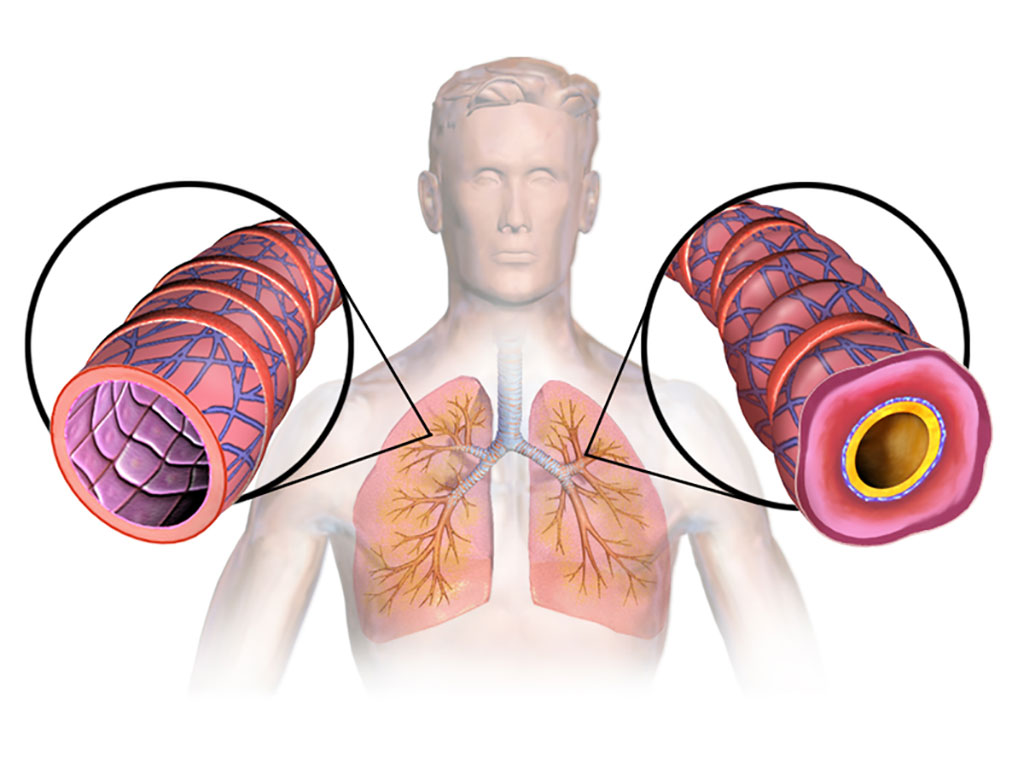Monitoring of Urinary Eicosanoids Distinguishes Mild and Severe Asthma
By LabMedica International staff writers
Posted on 26 Jan 2021
A novel method for diagnosing severe asthma is based on the monitoring of eicosanoid compounds in samples of urine.Posted on 26 Jan 2021
Eicosanoids are signaling molecules generated by the enzymatic or non-enzymatic oxidation of arachidonic acid or other polyunsaturated fatty acids that are similar to arachidonic acid. Eicosanoids are a sub-category of oxylipins, i.e. oxidized fatty acids of diverse carbon units in length, and are distinguished from other oxylipins by their importance as cell signaling molecules. As such, eicosanoids function in diverse physiological systems and pathological processes.

Image: Diagram of asthma (Photo courtesy of Wikimedia Commons)
Various eicosanoids are known to exert pro- or anti-inflammatory actions contributing to the pathobiology of asthma. However, their relative abundance in individuals with asthma and association with severe asthma are unclear. In addition, the influence of oral corticosteroid (OCS) treatment on eicosanoid concentrations has not been thoroughly investigated.
Investigators at the Karolinska Institutet (Stockholm, Sweden) used mass spectrometry-based methodology to quantify urinary metabolites of prostaglandins (PGs), cysteinyl leukotrienes (CysLTs), and isoprostanes in samples provided by participants in the U-BIOPRED (Unbiased Biomarkers for the Prediction of Respiratory Diseases Outcomes) study. The cohort comprised 86 adults with mild-to-moderate asthma (MMA), 411 with severe asthma (SA), and 100 healthy control participants. Validation was performed using samples from 302 participants with SA followed up after 12–18 months and on samples from 95 adolescents with asthma.
Results revealed that metabolite concentrations in healthy control participants were unrelated to age, body mass index, and sex, except for the PGE2 pathway. Eicosanoid concentrations were generally greater in participants with MMA relative to healthy control participants, with further elevations in participants with SA.
Metabolite concentrations were unchanged in those with asthma who adhered to oral corticosteroid treatment as documented by urinary prednisolone detection, whereas those with SA treated with omalizumab had lower concentrations of LTE4 and the PGD2 metabolite 2,3-dinor-11beta-PGF2alpha. Omalizumab, which is a recombinant DNA-derived humanized monoclonal antibody that specifically binds to free and membrane-bound human immunoglobulin E, is used to treat people with severe, persistent allergic asthma, uncontrollable with oral or injectable corticosteroids.
In addition, high concentrations of LTE4 and PGD2 metabolites were associated with lower lung function and increased amounts of exhaled nitric oxide and eosinophil markers in blood, sputum, and urine in U-BIOPRED participants and in adolescents with asthma.
"There are no simple methods to determine what type of asthma an individual has, knowledge that is particularly important in order to better treat patients suffering from the more severe types of the disease," said senior author Dr. Craig Wheelock, associate professor of medical biochemistry and biophysics at the Karolinska Institutet.
The asthma study was published in the January 1, 2021, online edition of the American Journal of Respiratory and Critical Care Medicine.
Related Links:
Karolinska Institutet







 Analyzer.jpg)






